In my last post, I looked at the way that, in the absence of a clear, shared understanding of what ‘personalization’ means, it has come to be used as a slogan for the promoters of edtech. In this post, I want to look a little more closely at the constellation of meanings that are associated with the term, suggest a way of evaluating just how ‘personalized’ an instructional method might be, and look at recent research into ‘personalized learning’.
In English language teaching, ‘personalization’ often carries a rather different meaning than it does in broader educational discourse. Jeremy Harmer (Harmer, 2012: 276) defines it as ‘when students use language to talk about themselves and things which interest them’. Most commonly, this is in the context of ‘freer’ language practice of grammar or vocabulary of the following kind: ‘Complete the sentences so that they are true for you’. It is this meaning that Scott Thornbury refers to first in his entry for ‘Personalization’ in his ‘An A-Z of ELT’ (Thornbury, 2006: 160). He goes on, however, to expand his definition of the term to include humanistic approaches such as Community Language Learning / Counseling learning (CLL), where learners decide the content of a lesson, where they have agency. I imagine that no one would disagree that an approach such as this is more ‘personalized’ than a ‘complete-the-sentences-so-they-are-true-for you’ exercise to practise the present perfect.
Outside of ELT, ‘personalization’ has been used to refer to everything from ‘from customized interfaces to adaptive tutors, from student-centered classrooms to learning management systems’ (Bulger, 2016: 3). The graphic below (from Bulger, 2016: 3) illustrates just how wide the definitional reach of ‘personalization’ is.
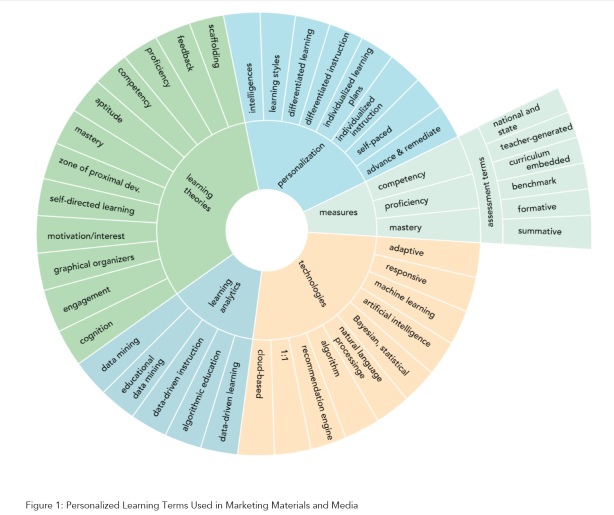
As with Thornbury’s entry in his ‘A – Z of ELT’, it seems uncontentious to say that some things are more ‘personalized’ than others.
Given the current and historical problems with defining the term, it’s not surprising that a number of people have attempted to develop frameworks that can help us to get to grips with the thorny question of ‘personalization’. In the context of language teaching / learning, Renée Disick (Disick, 1975: 58) offered the following categorisation:
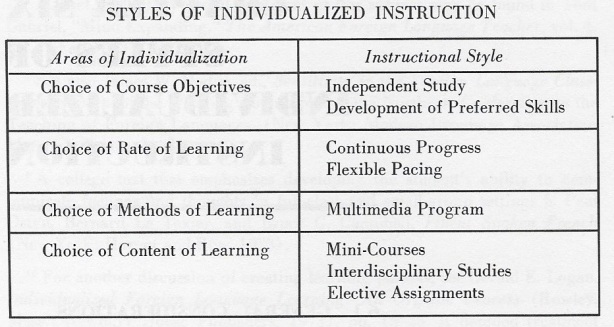
In a similar vein, a few years later, Howard Altman (Altman, 1980) suggested that teaching activities can differ in four main ways: the time allocated for learning, the curricular goal, the mode of learning and instructional expectations (personalized goal setting). He then offered eight permutations of these variables (see below, Altman, 1980: 9), although many more are imaginable.
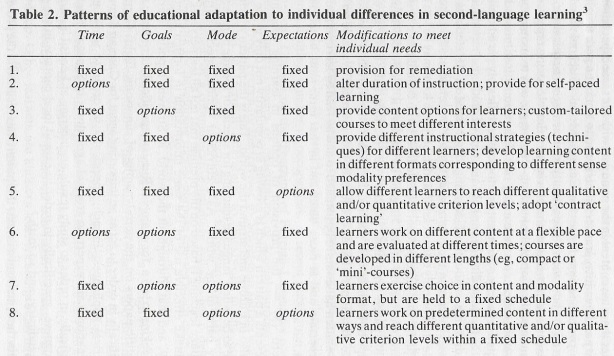
Altman and Disick were writing, of course, long before our current technology-oriented view of ‘personalization’ became commonplace. The recent classification of technologically-enabled personalized learning systems by Monica Bulger (see below, Bulger, 2016: 6) reflects how times have changed.
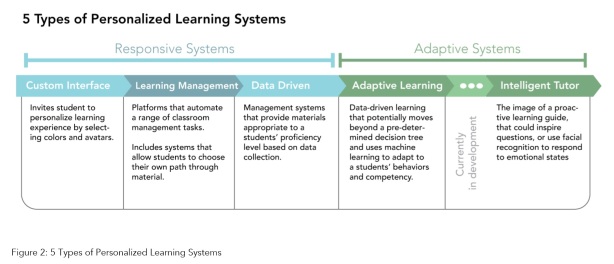
Bulger’s classification focusses on the technology more than the learning, but her continuum is very much in keeping with the views of Disick and Altman. Some approaches are more personalized than others.
The extent to which choices are offered determines the degree of individualization in a particular program. (Disick, 1975: 5)
It is important to remember that learner-centered language teaching is not a point, but rather a continuum. (Altman, 1980: 6)
Larry Cuban has also recently begun to use a continuum as a way of understanding the practices of ‘personalization’ that he observes as part of his research. The overall goals of schooling at both ends of the curriculum are not dissimilar: helping ‘children grow into adults who are creative thinkers, help their communities, enter jobs and succeed in careers, and become thoughtful, mindful adults’.
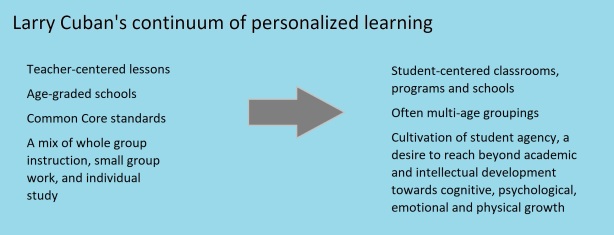
As Cuban and others before him (e.g. Januszewski, 2001: 57) make clear, the two perspectives are not completely independent of each other. Nevertheless, we can see that one end of this continuum is likely to be materials-centred with the other learner-centred (Dickinson, 1987: 57). At one end, teachers (or their LMS replacements) are more likely to be content-providers and enact traditional roles. At the other, teachers’ roles are ‘more like those of coaches or facilitators’ (Cavanagh, 2014). In short, one end of the continuum is personalization for the learner; the other end is personalization by the learner.
It makes little sense, therefore, to talk about personalized learning as being a ‘good’ or a ‘bad’ thing. We might perceive one form of personalized learning to be more personalized than another, but that does not mean it is any ‘better’ or more effective. The only possible approach is to consider and evaluate the different elements of personalization in an attempt to establish, first, from a theoretical point of view whether they are likely to lead to learning gains, and, second, from an evidence-based perspective whether any learning gains are measurable. In recent posts on this blog, I have been attempting to do that with elements such as learning styles , self-pacing and goal-setting.
Unfortunately, but perhaps not surprisingly, none of the elements that we associate with ‘personalization’ will lead to clear, demonstrable learning gains. A report commissioned by the Gates Foundation (Pane et al, 2015) to find evidence of the efficacy of personalized learning did not, despite its subtitle (‘Promising Evidence on Personalized Learning’), manage to come up with any firm and unequivocal evidence (see Riley, 2017). ‘No single element of personalized learning was able to discriminate between the schools with the largest achievement effects and the others in the sample; however, we did identify groups of elements that, when present together, distinguished the success cases from others’, wrote the authors (Pane et al., 2015: 28). Undeterred, another report (Pane et al., 2017) was commissioned: in this the authors were unable to do better than a very hedged conclusion: ‘There is suggestive evidence that greater implementation of PL practices may be related to more positive effects on achievement; however, this finding requires confirmation through further research’ (my emphases). Don’t hold your breath!
In commissioning the reports, the Gates Foundation were probably asking the wrong question. The conceptual elasticity of the term ‘personalization’ makes its operationalization in any empirical study highly problematic. Meaningful comparison of empirical findings would, as David Hartley notes, be hard because ‘it is unlikely that any conceptual consistency would emerge across studies’ (Hartley, 2008: 378). The question of what works is unlikely to provide a useful (in the sense of actionable) response.
In a new white paper out this week, “A blueprint for breakthroughs,” Michael Horn and I argue that simply asking what works stops short of the real question at the heart of a truly personalized system: what works, for which students, in what circumstances? Without this level of specificity and understanding of contextual factors, we’ll be stuck understanding only what works on average despite aspirations to reach each individual student (not to mention mounting evidence that “average” itself is a flawed construct). Moreover, we’ll fail to unearth theories of why certain interventions work in certain circumstances. And without that theoretical underpinning, scaling personalized learning approaches with predictable quality will remain challenging. Otherwise, as more schools embrace personalized learning, at best each school will have to go at it alone and figure out by trial and error what works for each student. Worse still, if we don’t support better research, “personalized” schools could end up looking radically different but yielding similar results to our traditional system. In other words, we risk rushing ahead with promising structural changes inherent to personalized learning—reorganizing space, integrating technology tools, freeing up seat-time—without arming educators with reliable and specific information about how to personalize to their particular students or what to do, for which students, in what circumstances. (Freeland Fisher, 2016)
References
Altman, H.B. 1980. ‘Foreign language teaching: focus on the learner’ in Altman, H.B. & James, C.V. (eds.) 1980. Foreign Language Teaching: Meeting Individual Needs. Oxford: Pergamon Press, pp.1 – 16
Bulger, M. 2016. Personalized Learning: The Conversations We’re Not Having. New York: Data and Society Research Institute. https://www.datasociety.net/pubs/ecl/PersonalizedLearning_primer_2016.pdf
Cavanagh, S. 2014. ‘What Is ‘Personalized Learning’? Educators Seek Clarity’ Education Week http://www.edweek.org/ew/articles/2014/10/22/09pl-overview.h34.html
Dickinson, L. 1987. Self-instruction in Language Learning. Cambridge: Cambridge University Press
Disick, R.S. 1975 Individualizing Language Instruction: Strategies and Methods. New York: Harcourt Brace Jovanovich
Freeland Fisher, J. 2016. ‘The inconvenient truth about personalized learning’ [Blog post] retrieved from http://www.christenseninstitute.org/blog/the-inconvenient-truth-about-personalized-learning/ (May 4, 2016)
Harmer, J. 2012. Essential Teacher Knowledge. Harlow: Pearson Education
Hartley, D. 2008. ‘Education, Markets and the Pedagogy of Personalisation’ British Journal of Educational Studies 56 / 4: 365 – 381
Januszewski, A. 2001. Educational Technology: The Development of a Concept. Englewood, Colorado: Libraries Unlimited
Pane, J. F., Steiner, E. D., Baird, M. D. & Hamilton, L. S. 2015. Continued Progress: Promising Evidence on Personalized Learning. Seattle: Rand Corporation retrieved from http://www.rand.org/pubs/research_reports/RR1365.html
Pane, J.F., Steiner, E. D., Baird, M. D., Hamilton, L. S. & Pane, J.D. 2017. Informing Progress: Insights on Personalized Learning Implementation and Effects. Seattle: Rand Corporation retrieved from https://www.rand.org/pubs/research_reports/RR2042.html
Riley, B. 2017. ‘Personalization vs. How People Learn’ Educational Leadership 74 / 6: 68-73
Thornbury, S. 2006. An A – Z of ELT. Oxford: Macmillan Education
Great post, Philip – again! Just to update matters, the new edition of An A-Z of ELT (called The New A to Z of ELT – not change of article!) adds this (in the entry on personalization):
More recently, the term ‘personalization’ has been co-opted by proponents of adaptive learning to mean ‘adapting the course content to individual learners on the basis of their past performance on tests’. In this case, it is the program itself – rather than the learner – that is ‘personalizing’. A less ambiguous term might be individualization or customizing.
I would love to have been able to add this sentence of yours: ‘Unfortunately, but perhaps not surprisingly, none of the elements that we associate with ‘personalization’ will lead to clear, demonstrable learning gains.’
It is really about time that I got hold of a copy of the new edition!
[…] [Link] [Comment] […]
Here are two useful reads on personalization: one from Dan Willingham http://www.danielwillingham.com/daniel-willingham-science-and-education-blog/three-versions-of-personalized-learning-three-challenges
and one from Audrey Watters http://hackeducation.com/2017/07/18/personalization
Your post has been a valuable resource for my research. Thank you!
[…] Personalized learning – attempts to define it and its links to technology: see Personalized learning: Hydra and the power of ambiguity and Evaluating personalization […]